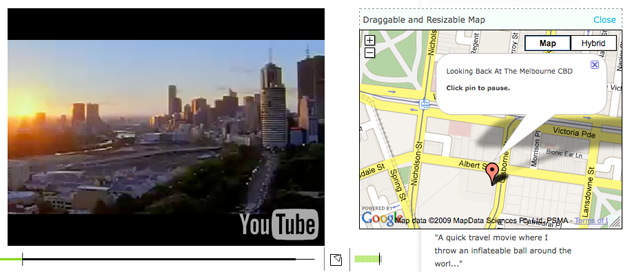| VisualPin Will Plot Your Videos On The Map Posted: 29 Jan 2009 08:10 PM PST Australian start-up VisualPin allows users to "geocode" their videos by adding a Google Map to each different location in a video, with the map appearing to the side of the video. Here's one of the best examples on the site. To be honest, I find the map somewhat distracting from watching the video but I think it could be useful when it comes to documenting travel, news or current events. The technology creates a virtual-location table of contents, allowing the user to click on a marked location to find the corresponding video content.
This appears to be a variation of existing technology that embeds YouTube videos in Google Maps listings. Also Google Maps mashups became particularly useful for news media sites during the inauguration; CNN, Oprah.com and WashingtonPost.com all featured geocoded mashup videos from inaugural events in Washington D.C. Perhaps NBC's Today show could use this technology for its next Where in the World is Matt Lauer series. |
Travel affects us all. Travel teaches us how to relate to one another, and trade helps us build commerce that supports unilaterally.
Friday, January 30, 2009
wheres that at?
Tuesday, January 27, 2009
Keeping Track
TripIt Launches An API. Travel Sites, Please Use It
Posted: 26 Jan 2009 09:19 AM PST

TripIt, the helpful travel site that lets you generate an itinerary by simply forwarding the service your Email confirmations from hotels and airlines, has opened up an API for outside developers. The API will give third party applications access to TripIt's itinerary sysytem, which now accepts data from 350 travel sites. Developers can find all the details for joining the program here.
A number of applications have already used the API to implement new features. Expensd, an online service that helps business travelers manage their expenses, will use TripIt to automatically import your transit and hotel expenses. Popular iPhone application FlightTrack will use TripIt to automatically look up your flights to see if they're on time. And Where I've Been, a social network application that plots your travels on a map for your friends to see, will use the API to automatically look up your destinations. Other potential uses for the API include an 'Add To TripIt' button that would allow travel sites to transmit your booking data to TripIt so you won't have to forward your confirmation Email.
TripIt is a great service, especially for frequent travelers (it has been on Michael's list of products he can't live without for two years running). I'm excited to see what developers can come up with - hopefully some major travel booking sites will get a clue too, and start offering that 'add to TripIt' button so we can skip the Email forwarding.
Sunday, January 18, 2009
Is Humanity a Spacefaring Race?
| By Seth Shostak SETI Institute posted: 15 January 2009 8:57 am ET |
We're destined to go to the stars. That's the assumption we've been making for a century, and I daresay most readers believe this as surely as they believe we'll eventually cure dandruff.
Our anticipation of an interstellar destiny is not merely the consequence of too many couch-hours spent watching Spandex-suitedastronauts in Star Trek, Star Wars, or Futurama. It's been a subtext of our space program. You might recall a low-grade, 1960 biopic about Wernher von Braun entitled I Aim at the Stars. Or perhaps you know the sunny motto of the National Space Society: "ad astra" ("to the stars"). Boldly sending our descendants into the galaxy's stellar realms seems as inevitable as teen sex.
I like the idea of becoming a spacefaring society. It's just a matter of how far we'll fare. Yes, we'll colonize our cosmic backyard; after all, if our species has not spread beyond Earth within a century, then we're headed for eternal internal conflict and armageddon@home. In the words of rocket pioneer Konstantin Tsiolkovsky, humans can't stay in the cradle forever.
I trust we'll soon be landing people on Mars, and eventually the satellites of the outer planets. I anticipate the construction of space habitats on the moon, the asteroids, and in orbit around Earth.
But colonizing the vicinities of other stars is enormously harder than settling the solar system. Our fastest rockets can take us to Neptune in less than a decade - a long ride, but not inconceivable. On the other hand, a trip to the closest star system, Alpha Centauri, would take 75,000 years.
Since our lifetimes are typically a century or less, practical travel to the stars requires relativistic velocities. Sending a 100-ton habitat, stuffed with a small crew, to Alpha Centauri at a speed that will deliver them before they turn up their toes requires as much energy as the United States consumes in a year. At standard utility rates, that will cost you about $3 trillion, just for the fuel.
Now this is a familiar discourse, and the usual rejoinder is to appeal to the inevitable development of faster rockets. We'll still go to the stars; we just need better transport.
But permit me to point out something both relevant and important: our remote sensing technology is improving much faster than our rocket technology. And that is a game-changing circumstance.
Let's look at some numbers. Von Braun's V-2 rockets crossed the English Channel at 1 mile per second. NASA's New Horizons mission to Pluto - the fastest spacecraft ever launched - is headed to this erstwhile planet at 10 miles per second. That's an order-of-magnitude improvement after 70 years.
Now consider one component of our remote sensing capabilities - our ability to "see" what we're exploring. The Mariner 4 spacecraft - the first to snap decent photos of Mars - was fitted with a monochrome TV camera having a resolution of 40 thousand pixels. In the summer of 1965, it sailed by the red planet while imaging craters as small as a few miles across.
Today, the HiRISE camera on NASA's Mars Reconnaissance Orbiter boasts a resolution of 200 million pixels (and shoots in color). It can discern items on the surface as small as a horse.
In other words, in seven decades our rockets sped up by a factor of ten, but in little more than half that time our cameras improved by a factor of five thousand. There's no comparison: probe technology is marching to the beat of a faster drummer.
Probes have always offered the advantage of lower cost and minimal risk. For interstellar travel, their smaller size makes them especially practical. For the same energy bill, you could propel a one-ton reconnaissance craft to another star in one-tenth the time of sending even a small clutch of humans.
Now you might argue that human exploration is qualitatively different than sending mechanical proxies. We humans want toexperience the frontier, not just watch it come up on our computer screen. We want to smell it, feel it, and look around.
OK, but what if we could send back all those sensations with a fidelity as good as being there? That's becoming more and more practical. The bandwidth of a single human eye, recently measured at the University of Pennsylvania medical school, is roughly 2 megabytes per second. The bandwidth of your ears is much smaller - no more than a few hundred kilobytes per second. Your fingertips and other parts of your anatomy require even less of a data pipe.
In other words, we could send back everything a human could sense with a telemetry channel of, say, 10 megabytes per second. This is roughly the data rate you'll soon be getting off a blue-ray disk. It's not trivial to send data at this rate from star to star, but it's a lot easier than sending ourselves.
The technology that can propel us virtually into deep space is quickly outstripping the technology that can propel our protoplasm there. So while we envision our 23rd century descendants cruising the Milky Way in search of other beings or fresh real estate, my guess is that we'll send small robots instead - extensions to our neurons that can be both cheap and expendable.
To spread our descendants among the nearby worlds of our solar system is more than our destiny: it's an imperative for our future. But galactic exploration will be different: that's something we'll do from the comfort of our own homes. And we won't need the Spandex.
Wednesday, January 14, 2009
Piecing it together

Prado and Google bring masterpieces to Web
MADRID: Google and the Prado Museum here are making it possible for Web-surfing art lovers to study 14 of the museum's greatest works in minute detail without ever setting foot in Spain.
The project allows users of Google Earth to zoom in on high-resolution images of the works, scouring the canvas for details that would barely be visible to a museum visitor standing behind a velvet cordon.
Other major art museums, like the National Gallery in London, have made their collections available online, but the Prado is the first to produce such high-resolution reproductions on the Internet, Javier Rodríguez Zapatero, director of Google Spain, said.
The 14 works include Diego Velázquez's "Las Meninas," Hieronymus Bosch's tryptich, "The Garden of Earthly Delights" and Peter Paul Rubens's "The Three Graces."
Google Earth is a free geographical tool that uses satellite technology to produce maps, a virtual image of the earth and detailed views of everything from houses and famous buildings to corn fields.
Whether it is a tiny wasp resting on a white petal above the heads of Rubens's goddesses or faint stains of paint used to retouch "Las Meninas," the Prado project offers a privileged view of the works that is not available to the public, Google and museum officials said.
"What this project offers is a level of definition that normally only we, the staff of the museum, see," said Miguel Zuzaga, director of the Prado.
Rodríguez said Google took hundreds of photographs of the 14 paintings and patched them together; the reproduction of "The Garden of Earthly Delights" required 1,600 photos. The resolution of the reproductions was 1,400 times higher than would be achieved with the use of a 10 megapixel digital camera, he said.
"The fact you can view 14 great works of art from any point on the globe is another expression of our mission to democractize information," he said.
Zuzaga said that the online sample could be the beginning of a global art museum. "It's like, Google Earth: Google Art," he said. "This could do on the Internet what Gombrich did with his book, 'The Story of Art,"' he continued, referring to Ernst Gombrich's 1950 book, which is credited with making fine art accessible to millions of readers.
Zuzaga said the Prado feature on Google Earth was not a substitute for visiting the museum, but a complement that could enhance a visitor's appreciation.
In a presentation at the Prado on Tuesday, he pointed to a minute detail of Rogier van der Weyden's 1435 painting "The Descent from the Cross": the eye of St. John the Evangelist, swimming with glistening tears, is painted with a realism that is almost photographic.
Zuzaga, however, said nothing could replace the act of standing before a painting, or seeing it hung as part of a collection. "What we have here is a scientific level of detail," he said. "What we can access here is the body of the painting. But we cannot access its soul."
Rodríguez said that Google had paid for the project, which took six months to complete, but declined to say how much it had cost.
Those who want to gain access the Prado works online have to download Google Earth and search for the Prado Museum. Once the image zooms in on the museum, they should click on a white square that leads to thumbnails of the 14 paintings.
Wednesday, January 07, 2009
Home Away from Home
Use Otalo To Search For Vacation Rentals
Posted at TechCrunch: 06 Jan 2009 11:13 PM PST

Vacation rentals are big business. HomeAway, which owns a dozen or so vacation home listing sites, just raised $250 million in a venture round that values the company at more than $1 billion.
But listings are spread across lots of sites - what the industry needed was a good central search engine for all those vacation home rentals. It's also a pain to do lots of searches on different sites because you have to enter where and when you want to go, making it a lot more complicated that a standard search engine query.
That's just what Otalo, which just launched, is doing. They are starting off with 200,000 listings. The company was founded by Michael Giles (the founder of Furl) and Baer Tierkel. The name Otalo comes from the Zen symbol enzo - "O" - with the Finnish word for house - "talo."
The company will earn commissions from the referral of customers to the various vacation rental sites. By the way, if you always stay in hotels on trips, you should try renting a house sometimes. It's much calmer and usually a lot cheaper. You can also get great deals at the last minute.
Monday, January 05, 2009
Blog Archive
Other Sites I Enjoy
- Pajamas Media
- iPlot: Technology, Drama, the Market, and I (Tim Leberecht)
- How to Change the World (Guy Kawsaki)
- planetargonautes
- the Long Tail
- Beyond the Brand
- high.tv
- local media network
- The Globe And Mail
- Broadcast Web Ideas
- mtheory entertainment
- broadband enterprises
- Mashable
- ignition partners
- bain capital ventures
- Spark Capital



